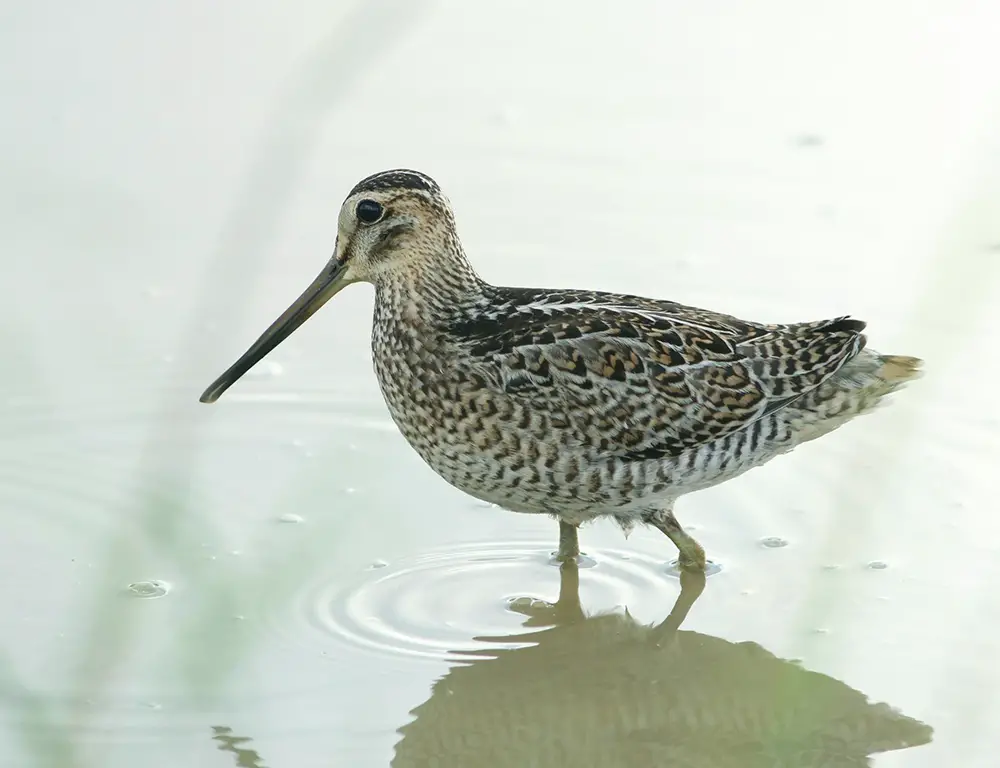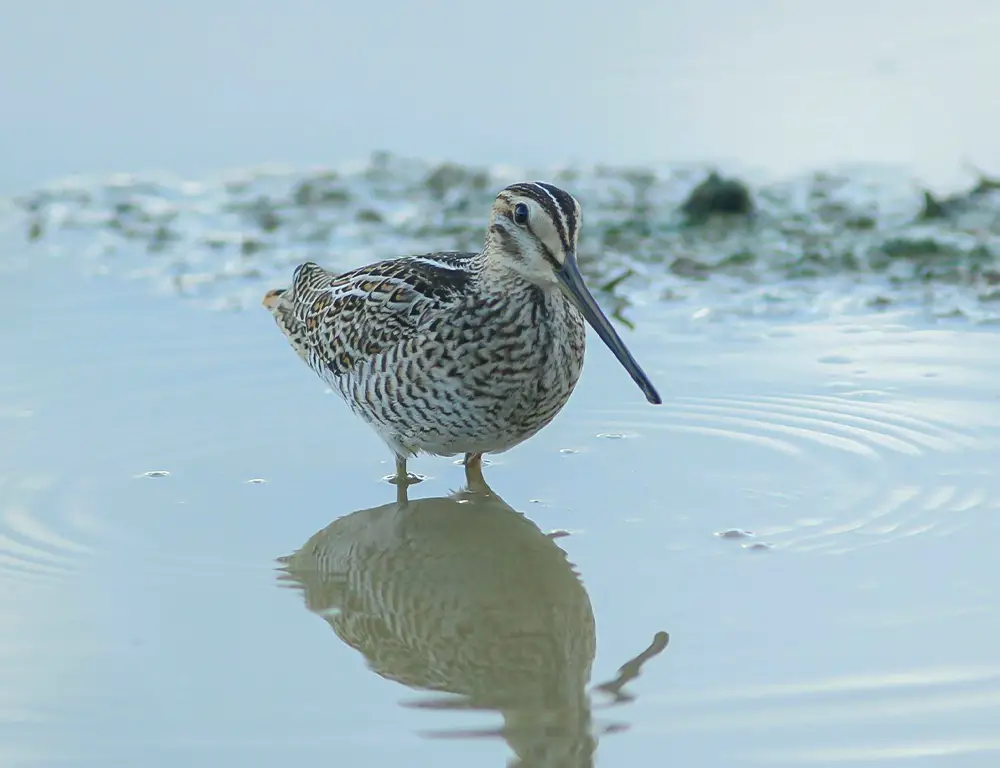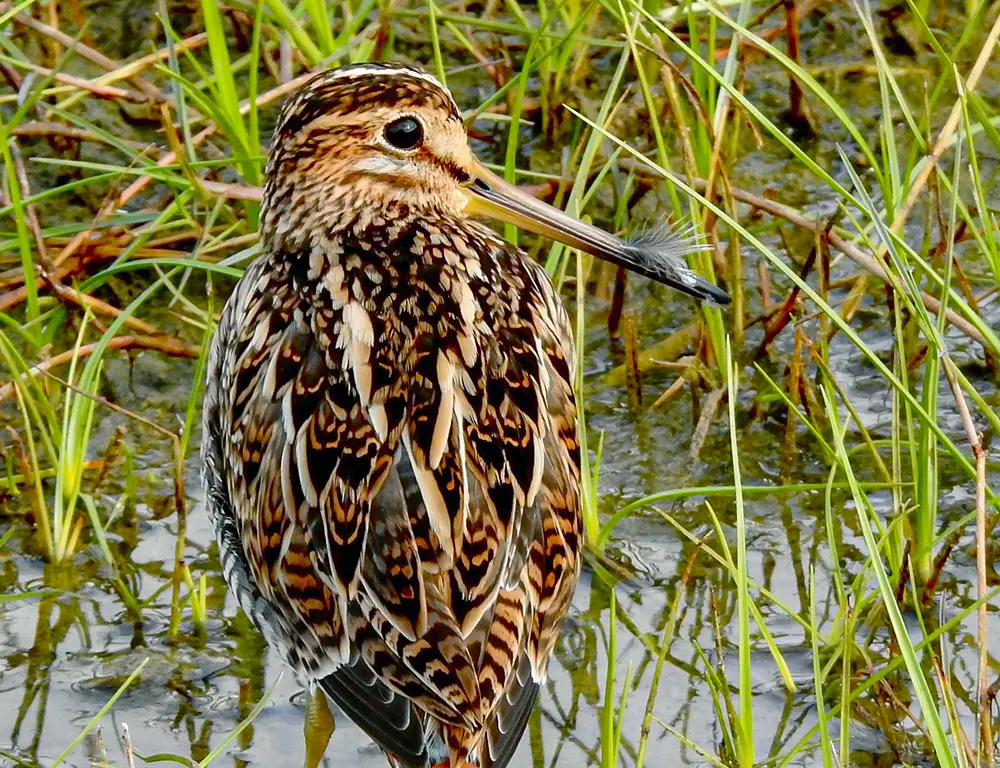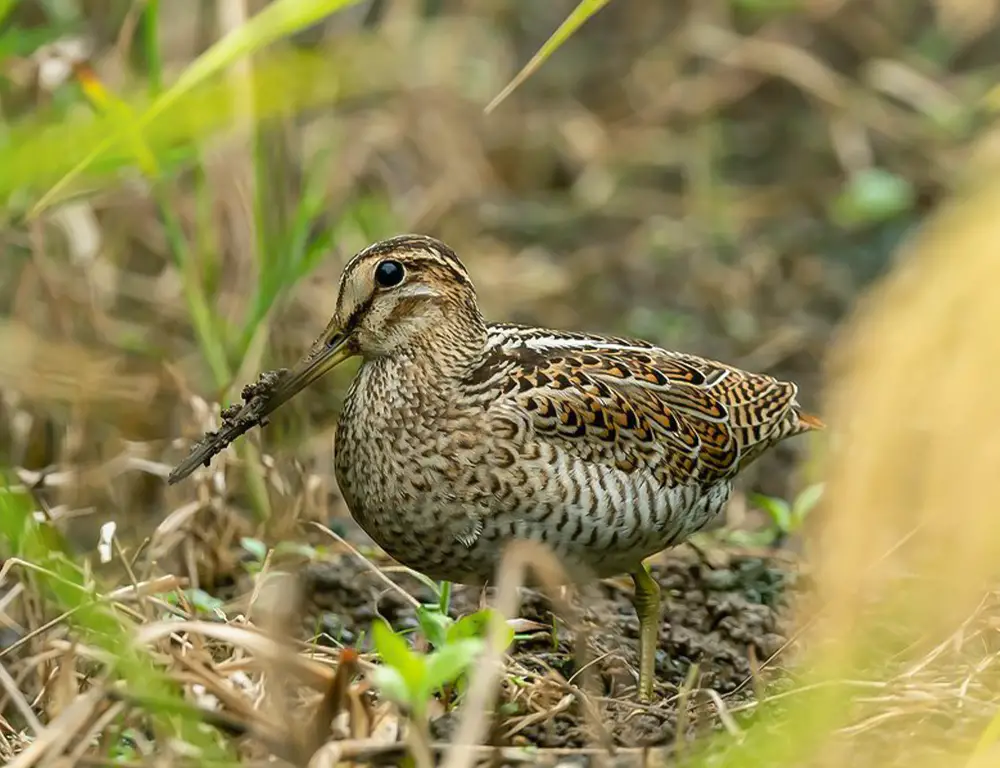The Pin-Tailed Snipe, a member of the sandpiper family, is captivating with its distinctive features and remarkable behaviors. With its long bill and impeccably camouflaged plumage, this bird stands out as a fascinating subject of study.
Thriving in diverse habitats ranging from wetlands to grasslands, it showcases remarkable versatility in adaptation. Originating from Asia, the Pin-Tailed Snipe embarks on an awe-inspiring migratory journey each year.
From breeding grounds in Siberia and Mongolia, it traverses thousands of miles to wintering sites in South Asia and Australia.
However, What truly astounds observers is the vast distances covered and the unique flight strategy employed – soaring at high altitudes over mountains.
This behavior underscores these birds’ incredible endurance and resilience, making them a source of endless fascination for birdwatchers and researchers alike.
Physical Characteristics of the Pin-Tailed Snipe

The physical characteristics of the Pin-Tailed Snipe contribute to its unique appearance and functionality in its environment. Here’s a summary of the key points:
Size
The Pin-Tailed Snipe is a medium-sized bird, typically measuring 25 to 27 cm (9.8 to 10.6 inches), with a wingspan ranging from approximately 50 to 55 cm (19.7 to 21.6 inches). This size range allows for efficient flight and foraging capabilities.
Coloration and Feather Pattern
These birds are covered in dark brown feathers with lighter streaks across their back and wings, providing excellent camouflage in their marshy habitats.
This coloration helps them blend seamlessly with their surroundings, making them less conspicuous to predators and prey.
‘Pin Tail’
The most distinctive feature of the Pin-Tailed Snipe is its namesake ‘pin tail’. This feature is derived from several tail feathers extending beyond the rest, forming pin-like structures.
These ‘pin tails’ are more pronounced in males and are used during display flights, likely as a visual signal to attract mates or establish territory.
Beak
The Pin-Tailed Snipe has a long, straight beak perfectly adapted for probing soil and mud as they forage for food. This specialized beak allows them to access hidden prey such as insects, worms, and crustaceans precisely.
Eyes
Their eyes are small yet piercing, typically colored in shades of hazel or light brown. This eye coloration may offer camouflage benefits and aids in visual acuity for hunting and navigating their environment.
Habitat and Distribution of the Pin-Tailed Snipe

Despite being often overlooked, the Pin-Tailed Snipe occupies diverse habitats and exhibits migratory behavior. Here’s a summary of their habitat and distribution:
Habitat
Pin-tailed Snipes are adaptable birds found in various habitats, including marshes, wet meadows, and rice fields. They thrive in both wild grasslands and lush wetlands, showcasing their ability to adapt to different environmental conditions.
Migration
As winter approaches and temperatures drop, Pin-tailed Snipes embark on migratory journeys toward warmer climates. This typically involves a southward migration to tropical regions such as Southeast Asia or Northern Australia, where they can find suitable wintering grounds.
Distribution
The distribution of Pin-tailed Snipes is widespread, with populations scattered across different regions. According to available data:
- Russia: Estimated to have 1000-10,000 pairs.
- China: Population estimates range from 100-10,000 pairs.
- Japan: The population is relatively small, with less than 50 pairs recorded.
This distribution highlights the global presence of Pin-tailed Snipes, though population densities vary significantly among different countries.
Threats
Despite their adaptability, Pin-tailed Snipes face threats from habitat loss, mainly due to wetland destruction caused by urban development.
Shrinking habitats pose a significant challenge to their survival, emphasizing the need for conservation efforts to protect their natural habitats.
Behavior and Diet of the Pin-Tailed Snipe

The behavior and diet of the pin-tailed snipe reveal fascinating adaptations to its environment and life cycle. Here’s a breakdown of their behavior and dietary habits:
Camouflage and Solitary Behavior
Pin-tailed snipes rely on their exceptional camouflage skills to blend into their marshy habitat, leading a secretive life. They are generally solitary birds or found in small groups outside of the breeding season, likely to avoid detection by predators.
Breeding Season Behavior
During the breeding season, male pin-tailed snipes become territorial and engage in impressive aerial displays to attract females.
This behavior is a common strategy among many bird species during mating season, aimed at securing mates and establishing breeding territories.
Omnivorous Diet
Pin-tailed snipes have an omnivorous diet, feeding on various food sources, including insects, worms, small crustaceans, seeds, and plant material.
Their long bill specializes in probing deep into soft mud to access hidden prey, demonstrating their adaptability in foraging techniques.
Feeding Rhythm
Pin-tailed snipes exhibit a feeding rhythm, most active during twilight hours (dawn and dusk). This behavior allows them to take advantage of reduced heat and fewer predators during these times, enhancing their foraging efficiency and reducing predation risk.
Migration
Pin-tailed snipes undertake long-distance migrations from their Asian breeding grounds to wintering sites as far south as Australia.
During this journey, they make few stops and can fly for days without rest, showcasing remarkable endurance and adaptation to seasonal changes.
Conservation Status of the Pin-Tailed Snipe

The Pin-tailed Snipe currently holds a conservation status of “Least Concern” according to the International Union for Conservation of Nature (IUCN). This designation indicates that the species is widespread and abundant, with no immediate threats to survival.
However, several factors warrant attention regarding their conservation:
Habitat Loss
The primary concern for Pin-tailed Snipes is habitat loss, particularly the draining of wetlands and marshy areas for agricultural or developmental purposes.
This loss deprives them of their natural habitat and reduces their access to essential feeding grounds, impacting their ability to find food.
Adaptability
Despite facing habitat challenges, Pin-tailed Snipes have demonstrated adaptability by being spotted in alternative habitats such as rice fields and urban parks.
Their ability to utilize a variety of environments with sufficient water and food resources contributes to their resilience in the face of habitat loss.
Geographical Range
The Pin-tailed Snipe’s wide geographical range across Eurasia, from nesting sites in Siberia to wintering spots in Australia and Africa, enhances their resilience.
This broad distribution provides them nesting, wintering, and migration options, reducing their vulnerability to localized threats.
Migration Routes
While the species’ migration routes may vary based on human activity or climate fluctuations, Pin-tailed Snipes exhibit flexibility in adapting to changing conditions. This variability in migration routes allows them to seek suitable habitats and resources as needed.
Conclusion
The pin-tailed snipe is a remarkable testament to nature’s ingenuity and resilience. Its awe-inspiring migratory journeys, unique feeding behavior, and mastery of camouflage underscore its exceptional adaptability.
Yet, amid its remarkable traits, the species faces mounting threats from habitat loss due to human activities. Understanding and appreciating the complexities of the pin-tailed snipe’s life highlights the urgent need for intensified conservation efforts.
By safeguarding their wetland habitats and addressing the challenges they confront, we can ensure the continued presence of these captivating birds in our ecosystems.
Our commitment to biodiversity conservation honors the intricate web of life and our shared responsibility to preserve it for future generations.